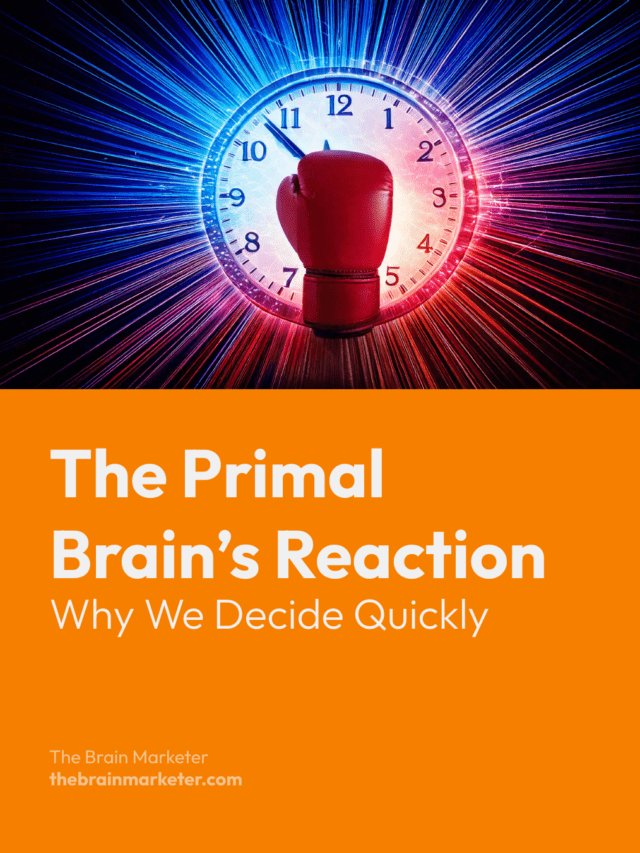The primal brain, also known as the reptilian brain, is the most ancient part of our brain evolved to ensure survival. Its core function is to trigger fast, instinctive reactions to threats or opportunities, often before we even become consciously aware of them. In today’s marketing landscape, this instinct still governs many of our decisions, especially when they’re made in seconds.
This article explores how brands design their strategies to appeal to this fast-acting part of the brain, influencing behavior by simplifying decisions and evoking strong emotional responses.
Key Takeaways
- The primal brain controls fast, unconscious decisions linked to survival.
- It’s triggered by core needs: safety, urgency, pleasure and fear.
- Brands activate the decision-making nuclei through emotional and sensory stimuli.
- Emotion-driven marketing outpaces logic-based messaging.
- Reducing cognitive load makes action faster and more intuitive.
🎙️ Unpack the Topic with this Podcast
Fast Decisions for Survival (and for Sales)
From an evolutionary standpoint, reacting quickly to external stimuli meant survival. The primal brain processes basic survival cues like safety, food and reproduction. Today, these instincts still guide us when faced with everyday consumer decisions.
Example: Platforms like Amazon capitalize on this instinct with “One-Click Buy” and flash deals. The immediate “Buy Now” option removes friction and limits reflection, triggering the primal desire for instant gratification.
The Trader’s Brain: Quick Thinking in High-Stakes Environments
Instinctive decision-making also plays out in modern contexts like stock trading, where milliseconds can determine gain or loss. Here, the brain’s decision-making nuclei activate motor and emotional responses, enabling rapid action without deliberate thought.
Example: McDonald’s uses color, layout and streamlined menus to reduce cognitive effort. Bright visuals and simple options allow customers to choose quickly, often without analyzing every choice.
Marketers apply the same logic: remove friction and let instincts lead.
Stimulating the Decision-Making Nuclei
The primal brain responds to specific neurological structures known as the decision-making nuclei. These centers respond to emotional triggers such as urgency, scarcity or anticipation.
Example: Apple’s limited product drops, paired with high anticipation and FOMO, generate emotional pressure that leads to quick action. Scarcity cues intensify the urge to act before missing out.
Why Emotions Work Faster Than Logic
The primal brain is emotionally driven. Feelings bypass rational thought, guiding choices faster than logic ever could. Successful marketing taps into joy, fear, excitement and desire to prompt immediate action.
Example: Coca-Cola’s “Open Happiness” campaign associates the product with positive emotional states. This creates a subconscious link that leads to a quick purchase without deliberation.
Reduce Cognitive Load, Increase Action
When faced with too many choices or too much information, the brain stalls. The primal brain seeks clarity and simplicity, avoiding complexity whenever possible.
Example: Apple’s minimalist stores and interfaces create an experience where choices feel intuitive. Fewer distractions mean faster decisions and more conversions.
Conclusion: Design for Instinct, Not Just Intellect
Whether we’re dodging danger or clicking “Buy Now,” the primal brain drives fast reactions. Brands that understand this psychology build strategies that:
- Simplify choices and remove friction
- Evoke emotional responses to bypass analysis
- Leverage urgency and reward cues to trigger fast action
When marketers design for instinctive behavior, they reduce hesitation and boost conversion. Just like a trader reacting to market shifts, a consumer driven by emotional cues doesn’t hesitate: they respond.
Sources
- Dooley, R. (2011). Brainfluence: 100 Ways to Persuade and Convince Consumers with Neuromarketing. Wiley.
- Bechara, A., Damasio, H., & Damasio, A. R. (2000). Emotion, decision making and the orbitofrontal cortex. Cerebral Cortex, 10(3), 295–307.
- Bagozzi, R. P., Gopinath, M., & Nyer, P. U. (1999). The role of emotions in marketing. Journal of the Academy of Marketing Science, 27(2), 184–206.

Vincent Heimann is a marketing project manager and neuromarketing enthusiast. He founded The Brain Marketer to bridge neuroscience and marketing through accessible, science-based content. With over 10 years of experience in digital strategy, UX/UI and communication, he shares practical insights to help brands connect with the human brain — ethically and effectively

